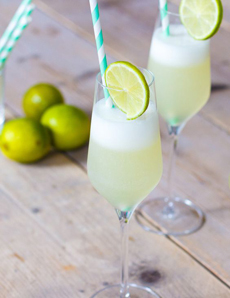TIP OF THE DAY: Sgroppino, A Lemon Sorbet Cocktail Recipe
|
Is it hot enough for you? Cool off with sgroppino, a sorbet cocktail. The recipe is below.
But first: Sgroppino (sgro-PEA-no), which originated in Venice, is a refreshing, frothy sorbet cocktail: a slushy combination of lemon sorbet, vodka, and prosecco. It’s served as a digestif (after-dinner drink) or liquid dessert. You don’t want very sweet drinks before a formal European-style dinner, but it works with hot and spicy cuisines. Sgroppino is no sweeter than a frozen Margarita. Sgroppino was created by an anonymous kitchen servant in 16th-century Venice. At that time, only wealthy households had the means to keep an ice house* and the staff to make sorbet (sorbetto in Italian) by hand. In the Venetian dialect, the drink is called sgropin from the verb sgropàre, which means to untie a small knot. The reference is to the knots in one’s stomach following the multi-course dinners of the wealthy. A sweet drink was believed to aid in digestion; hence the after-dinner liqueur. Sgroppino was also served as a palate cleanser† to refresh the taste buds between the fish and meat courses as well. This “intermezzo,” used to cleanse the palate of fish before moving on to meat, is still served at some fine restaurants today. The classic was made by whisking softened lemon sorbet with prosecco until frothy (it was described as “whipped snow,” although today we call it a slush). The recipe evolved to include limoncello, sambuca, or vodka. Today it can be both liqueur and vodka. More modern variations substitute grapefruit, orange, or strawberry sorbetto. If a larger percentage of sorbetto is added, you get a thicker drink. In its simplest form, it’s a scoop of sorbet topped with Prosecco, or vice versa. The drink separates if left to stand, so in Italy, the waiter will often prepare the drink at the tableside. |
 [1] If only every bar and restaurant served these (photo © What’s Cooking America.
[2] Chef Bikeski adds pomegranate arils for a bit of color. |
|
|
You can serve sgroppino in a martini glass, coupe, flute, or wine glass…or those “sherbet Champagne” glasses‡, designed for Marie Antoinette but not actually good for serving a sparkling wine. Ingredients Per Drink |
||
 [3] Some people prefer the cocktail to be separated. In this version, from Zoetrecepten, a scoop of lime sorbet is added to the top of the alcohol. |
Preparation
1. WHISK together the sorbet and a splash of prosecco until fully blended, using a cocktail shaker or a stainless steel bowl. Continue whisking while slowly pouring in the vodka and prosecco. 2. If using a liqueur, you can blend it with the vodka or drizzle it, Venice-style, into the center of the glass right before serving. 3. SERVE immediately. The drink will separate as it stands, so provide iced tea spoons or straws so people can re-blend as desired. If you take the modern approach of adding sorbet on top of the alcohol, you save the trouble of whisking! Some mixologists don’t blend the drink in the first place. Instead, they place the scoop of sorbet on top of the alcohol (see photo #3). So separation is not a bad thing, but a choice. |
|
|
___________________ *Before refrigeration, only the wealthy could afford to have ice cut from lakes and rivers in the winter and stored in ice houses for summer use. The oldest known ice house, built by a king in Persia, dates from about 1700 B.C.E. Most other people dug ice pits, lined with straw and sawdust as insulation. While commercial refrigeration was available by the late 1800s, the home refrigerator didn’t arrive until 1930. Prior to then, the wealthy as well as the middle class used an insulated metal “ice box,” which held a large block of ice delivered from the “ice man” to keep perishables cold. When the ice melted, it was replaced. †The tartness and citrus acid of lemon sorbet clear the taste buds. Citric acid elicits salivation, which aids in cleansing the palate. Lemons and limes have the highest level of citric acid, which can constitute as much as .3 mol/L, depending on the cultivar and growing conditions. By comparison, grapefruits and oranges have just .005 mol/L (source). Passionfruit also can work. It has 38.7 mg/100g compared to 30 mg/100g (source). ‡“Sherbet champagne” glasses were purportedly designed by Marie Antoinette, who had them molded after the shape of her breasts. Here’s a photo. They are rarely made anymore, as modern knowledge shows that a wide mouth-glass is not appropriate for sparkling wine: It lets the bubbles escape that much more quickly. But if you have these glasses, they’re just fine for serving sorbet, fruit cocktails, and other foods…or sgroppino. CHECK OUT WHAT’S HAPPENING ON OUR HOME PAGE, THENIBBLE.COM.
|
||



